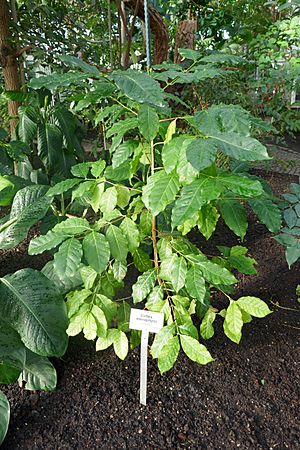Highland coffee facts for kids
Quick facts for kids Highland coffee |
|
|---|---|
 |
|
| Conservation status | |
| Scientific classification | |
| Genus: |
Coffea
|
| Species: |
stenophylla
|
Coffea stenophylla, also known as highland coffee or Sierra Leone coffee, is a type of coffee plant. It comes from West Africa.
This coffee is not grown much for sale today. This is because it produces fewer beans and smaller berries than other popular coffee types. These include Coffea arabica and Coffea canephora (robusta).
Scientists are studying C. stenophylla to see if it could be grown more widely. They hope it can help make the world's coffee supply stronger. This could help coffee plants deal with climate change and plant diseases better.
Contents
What is C. stenophylla?
C. stenophylla grows naturally in West African countries. These include Guinea, Ivory Coast, Liberia, and Sierra Leone.
This plant can grow as a shrub or a small tree. It can reach up to 20 feet (about 6 meters) tall. It is known to be a coffee type that can handle heat well.
When C. stenophylla berries are ripe, they turn a dark purple color. This is different from C. arabica berries, which turn red when they are ready.
People who have tasted C. stenophylla coffee say it has a great flavor. It is often described as complex and naturally sweet. It also has a good feel in the mouth, with a medium-high acidity and fruity taste.
Why is it called Stenophylla?
The name stenophylla comes from two ancient Greek words. Stenos means "narrow" and phyllon means "leaf". So, C. stenophylla means "narrow-leaved coffee".
How was C. stenophylla discovered?
The Swedish botanist Adam Afzelius first found C. stenophylla in the 1700s. Later, the Scottish botanist George Don officially wrote about it.
In 1894, some seeds were sent to the Royal Botanical Gardens in Kew, England. They were planted and grown there. Samples were also sent to Trinidad.
In 1898, a report from Trinidad said the plants had grown berries for the first time. This was four years after they were planted. The report said the coffee tasted excellent, just like the best Coffea arabica.
Even with its good taste, C. stenophylla was not grown widely. This is because it produces fewer and smaller berries than other coffee types.
In 2018, researchers looked for living C. stenophylla plants. They finally found wild plants in 2019 and 2020. These wild plants are now being grown. This will help protect the species and allow more studies on its taste and growth.
Future uses for C. stenophylla
Scientists believe C. stenophylla could be very important for the future of coffee. Aaron Davis, a coffee expert at Kew Gardens, says it can help make coffee plants more diverse.
Having more types of coffee plants helps them survive. It makes them stronger against climate change and diseases. One common disease is called coffee rust.
C. stenophylla grows well in lower areas, around 150 meters (about 500 feet) above sea level. Most coffee is grown at higher elevations, usually 800 meters (about 2,600 feet) or more. This means C. stenophylla could allow coffee to be grown in new places.
Since it can handle heat, some scientists think it could help coffee farmers. It might reduce the problems caused by a warming climate.
Threats to C. stenophylla
Even though it has been grown a little in West Africa, C. stenophylla is a vulnerable species. This means it is at risk of disappearing.
Its natural home in the Upper Guinean forests has seen a lot of deforestation. This means forests are being cut down. Also, its habitat is being broken into smaller pieces. These changes threaten the wild C. stenophylla plants.
See also
 In Spanish: Café de las tierras altas para niños
In Spanish: Café de las tierras altas para niños


